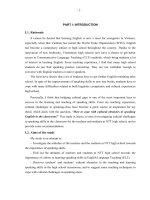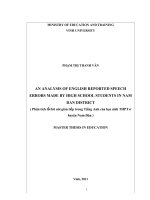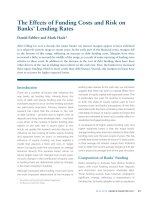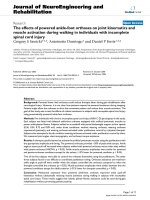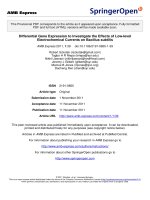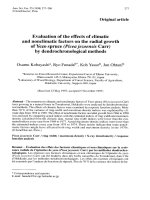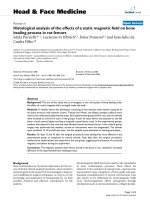The effects of test taking strategies instructions on reducing high school students’ test anxiety
Bạn đang xem bản rút gọn của tài liệu. Xem và tải ngay bản đầy đủ của tài liệu tại đây (141.03 KB, 13 trang )
Hanoi University
Department of Post graduate studies
MA Thesis Proposal
Name:
Class:
Institution: Department of Post graduate studies
Specialty: English
Thesis title: The effects of test-taking strategies instructions on reducing High
School students’ test anxiety.
Statement of the problem: Students are always nervous and anxious when they
take tests, and the test results do not truly reflect their competence.
The students at Duong Xa High School often make a surprise at their low test
results in spite of the fact that they show their good understanding and good ability
during the lessons. These students reveal that when taking tests, they are too
nervous to recall the knowledge and they become confused.
The related literature on test anxiety in language learning point out that the
factors that influence students’ reactions to language tests are perceptions of test
validity, time limit, test techniques, test format, length, testing environment and
clarity of test instructions (Young, 1999). In addition, the researchers show that
learners’ capacity, task difficulty, the fear of getting bad grades and lack of
preparation for the test are other factors that make test takers worried. Similarly,
learners with high levels of anxiety have less control of attention (Sarason, 1980,
1986). According to Chastain (1975), there was a negative correlation indicating
that low test anxiety was related to greater success. Last of all, in Ohata’s study
(2005) most of the participants said that they feared taking tests because test-taking
situation would make them fearful about the negative consequences of getting bad
grade. One form of test anxiety results from such things as poor study habits,
1
inadequate organizational skills, in-effective time management. When not prepared,
it is rational that the student is then faced with increased tension. Test anxiety
results when a student is adequately prepared for an exam but experiences
symptoms of physical, cognitive, behavioral, and emotional distress that inhibit to
some degree the ability to learn and perform.
Test anxiety becomes problematic when this nervousness is so high that it
interferes with test preparation and performance. Test anxiety produces bad results,
which makes students feel unconfident because the tests do not accurately measure
their abilities. Test anxiety is a major factor contributing to a variety of negative
outcomes including psychological distress, academic underachievement, academic
failure, and insecurity (Hembree, 1988). Many students have the cognitive ability to
do well on exams but may not do so because of high levels of test anxiety. Because
of the societal emphasis placed on testing, this could potentially limit their
educational and vocational opportunities (Zeidner, 1998).
Literature Review
Fundamental premise of test anxiety and test-taking strategy
Anxiety is described as an uncomfortable emotional state in which one perceives
danger, feels powerless and experiences tension in preparation for an expected
danger (Blau, 1995). Language anxiety is an effective factor that affects
achievement in second language (L2) (Gardner, 1985). Depending on the synthesis
of research context on L2 anxiety, Gardner and MacIntyre (1993) describes it as the
apprehension experienced when a situation requires the use of L2 with which the
individual is not fully proficient. Thus, L2 anxiety is described as a situationspecific anxiety. It has three varieties: Communicative apprehension, fear of
negative evaluation, and test anxiety.
Test anxiety is an apprehension over academic evaluation. It is a fear of failing in
test situations and an unpleasant experience held consciously or unconsciously by
learners in many situations. It is a type of anxiety concerning apprehension over
academic evaluation which comes from a fear of failure (Horwitz & Young, 1991).
2
Test anxiety is composed of three major components: cognitive, affective, and
behavioral. Students who experience test anxiety from the cognitive perspective are
worriers lacking self confidence. They may be preoccupied with negative thoughts,
doubting their academic ability and intellectual competence (Sarason, 1980).
Furthermore, they are more likely to overemphasize the potential negative results
and feel helpless when in testing situations (Zeidner, 1998). Some students may feel
the need to answer every question on the test correctly. When this does not occur
they may think of themselves as being incompetent, thus fueling negative thoughts
such as, "I knew I was not going to pass this test," "I know I am going to make a
poor grade," or "Everyone knows I am not smart." In order for students to have the
best opportunity for academic success, negative thinking must be minimized and
controlled.
From the affective perspective, test anxiety causes some students to experience
physiological reactions such as increased heart rate, feeling nauseated, frequent
urination, increased perspiration, cold hands, dry mouth, and muscle spasms
(Zeidner, 1998). These reactions may be present before, during, and even after the
test is completed. In conjunction with the physiological reactions, emotions such as
worry, fear of failure, and panic may be present. When students are not able to
control their emotions, they may experience higher levels of stress, thereby making
it more difficult for them to concentrate.
Test-anxious students express anxiety behaviorally by procrastinating and
having inefficient study and test-taking skills. Zeidner (1998) contends that testanxious students have a more difficult time interpreting information and organizing
it into larger patterns of meaning. In addition, some students may physically feel
tired or exhausted during test administration because they do not have a healthy
diet, have poor sleeping habits, and fail to routinely exercise.
When preparing for a test, research indicates that when students have tools and
strategies that build both emotional skills and healthy physical habits they can
overcome test anxiety and the associated symptoms. As a result, they improve their
ability to prepare for and perform on exams.
3
The most frequently mentioned strategies address the following areas:
•
Relaxation
•
Knowledge of testing conditions
•
Adequate preparation through improvement of test-taking and study skills
•
Effective health habits, exercise, and good nutrition
•
Monitoring of thinking patterns and positive self-talk
Scruggs & Mastropieri (1992) claimed that students who are test wise can
outperform students of equal ability but lacking test-wiseness. Teaching test-taking
strategies helps students understand the format and conventions of a specific type of
test and makes them feel comfortable in a testing environment. Learning test-taking
strategies actually improves the validity of a test by making scores reflect more
accurately what students know (Scruggs & Mastropieri, 1992). The primary purpose
of test-taking strategies is to improve student performance on exams. A second, but
related, purpose is to reduce exam anxiety. If both of these goals are achieved,
higher test scores should result. Kessleman-Turkel and Peterson (1981) supposed
that when you take a test - any test - you're really being tested on two things: how
much you know about the subject and how much you know about taking a test.
Test-taking strategies have the following advantages:
•
Improve test scores
•
Bolster student confidence about exams
•
Reduce exam anxiety
Research on test anxiety
Some researchers examined the test anxiety level of students as EFL learners and
investigated its reasons, effects and results on foreign language learning. For
example, Dr. Aydn S. (2005) found that the learners usually have test anxiety. 114
students in English Language Department of Necatibey Education Faculty of
Balikesir University, Turkey were the participants of the study. A background
questionnaire, Test Anxiety Scale (Sarason’s, 1984) and a survey were conducted.
The result revealed that test anxiety provoking factors are low level proficiency of
4
the learners, negative attitudes of teachers towards test applications, students’
attitude towards language learning, test invalidity, fear of negative evaluation, bad
experiences on tests, time limitation and pressure, the difficulty of course contents
and parental expectations. Test anxiety causes physical and psychological problems,
affects motivation, concentration and achievement negatively, increases errors in
learning process, prevents to transfer their real performance to test results and study
efficiently and decrease the interest towards language learning. The overall results
indicate that test anxiety is problematic education area and it can be coped with.
Larson et al. (2010) tested if relaxation techniques could reduce the negative
effects that self-perceived levels of test anxiety have on third-grade students. Their
subjects were 177 third-grade students aged 8-10 years old. The Westside test
anxiety scale (Driscoll, 2007), elevator breathing and guided relaxation were
utilized to measure and manage levels of anxiety. The results indicated that the
relaxation invention had a significant effect in reducing test anxiety in the
experimental group.
Chandler L. (2006) conducted a study on gender difference and test anxiety to
determine if male or female Ss have greater test anxiety on the high stakes testing.
85 students in the 4th, 6th, and 10th grade students in Chesapeake were asked to
complete the Revised Children’s Manifest Anxiety Scale (RCMAS: Peynolds &
Richmond, 1985). The results showed that there was a significant difference
between the 6th grade males and females during the pretest administration, with the
males showing more anxiety.
A study on relationship between language anxiety and proficiency was
conducted by Kondo (2003) to investigate the relationship between language
anxiety and proficiency in English. 1st year students at School of Education, Waseda
University were the participants. This study only found the poor predictor of
English proficiency, though many studies on language anxiety found high
correlation between anxiety and language proficiency. The author suggested that
even if that is the case in the context of Japan, researches in reducing anxiety should
be done.
5
Aydin et al. (2008) investigated the teacher effect on the level of test anxiety
among young EFL learners. Their subjects were 477 young learners from 5 primary
schools. Data collection instruments consisted of a questionnaire and Test Anxiety
Scale (TAS: Sarason, 1978). They found that the students who had positive attitudes
towards their English teachers felt more confident and relaxed and less nervous
even if they forgot what they knew. Moreover, the participants who had positive
attitudes towards their English teachers were less embarrassed during examinations,
felt less uneasy before getting their exam papers, and believed more strongly that it
was not possible to learn more without examinations. The findings demonstrate that
positive attitude towards EFL teachers decrease the levels of test anxiety among
young EFL learners.
Aydin (2008) had an investigation on the language anxiety and fear of negative
evaluation among Turkish EFL learners to investigate the sources and levels of
negative evaluation as well as language anxiety among Turkish Ss as EFL learners,
and to determine the correlation between the two. A foreign language anxiety scale
(FLAS: Horwitz et al., 1986) and a scale for fear of negative evaluation (FNE:
Leary, 1983) were administered to a sample group of 112 foreign language learners.
The results of the analysis indicated that EFL learners suffer from language anxiety
which is aroused by factors, such as un-preparedness for class, communication
apprehension with teachers, peers, and native speakers; teachers’ questions and
corrections in classroom environment; tests and negative attitudes towards English
course. The sources of fear of negative evaluation consist of negative judgments by
others, leaving unfavorable impression on others. In addition, fear of negative
evaluation is a strong source of foreign language anxiety. The author also pointed
out the limitation in term of the limited subjects and the data collection instrument.
He suggested that further study should focus on the relationship between language
anxiety and some other variables as well as the strategies and tactics to allay
language anxiety.
Gaps in the existing literature
Despite the use of test-taking strategies in reducing test anxiety and the amount
of related research, the above literature review exposed several gaps. First, there are
6
few studies on the effect of test-taking strategies on allaying test anxiety. A second
gap in the literature is that the participants in previous research have been university
or primary students. Thus, the present study will examine high school students.
Moreover, it is necessary to conduct a research that deeply investigates the effect of
test-taking strategies on allaying test anxiety. The test form at high school
nowadays is formally focused on multiple choice tests. As a result, the present
researcher will apply general test-taking strategies as well as test-taking strategies
instructions in specific test form situation of multiple choice tests to groups of high
school students to examine the effect of them on reducing test anxiety.
Aims of the research
The present study’s aim is to examine the effects of test-taking strategies
instructions on reducing Duong Xa High School students’ test anxiety and as a
result improving their test results.
Research questions
1. Are there any significant differences between students who receive testtaking strategies instruction and those who do not in term of their test anxiety
level?
2. What are the participants’ opinions of test-taking strategies used to reduce
their test anxiety and improve the test result?
Methodology
Participants
A total of 92 11- grade students taking English classes as a compulsory subject
at Duong Xa High School, Gia Lam, Ha Noi will take part in the study. There are
35 males and 57 females with the age of 16. The academic achievement of the
previous semester of school year 2011-2012 will be used as information about their
proficiency and as a part of their education background. The like about English will
be examined by background questionnaire at the beginning of the intervention. The
students in class 11A3 and 11A4 will be assigned to experimental and control
7
groups. The students in both classes have the similarity in term of gender, the like,
education background and their experience with test anxiety and test-taking
strategies. (The comparable features are assured because of the researcher who has
taken responsibility for the two classes for two years)
Research design
A quasi-experimental design will be chosen because the groups were not
randomly assigned.
Before the treatment program, all participants will be given a pre-test to measure
their proficiency and their level of test anxiety will be also measured by a Test
Anxiety Scale. The experimental and control groups will do the same tests
during the program, but the experimental group will have test-taking strategies
instruction, while control group will not. The post-test will be administered to
all participants after the intervention program.
Data collection instruments
Questionnaire (Appendix A) to collect information on the participants’
education background and their experience with test anxiety and test-taking
strategies instruction will be used. The questionnaire will consist of 15 items
designed by the present researcher for obtaining the participants’ education
background, their experience on test anxiety and test-taking strategies instructions.
Westside Test Anxiety Scale (WTAS) (Appendix B). Driscoll (2007) was
designed WTAS to identify participants with anxiety impairments who could
benefit from anxiety-reduction and yield a general test anxiety score. The present
researcher will use this scale to measure the degree of test anxiety after Pre- and
post-test (to answer research question 1). The WTAS consists of 10 items, each
using a Likert repose scale where 1 = “never true” and 5 = “always true”. The
WTAS was constructed to measure anxiety impairments with six items assessing
incapacity and four items measuring worry and dread which interferes with
concentration (Driscoll, 2007). Score for the two subscales, incapacity (items 1, 4,
5, 6, 8, & 10) and worry (items 2, 3, 7, & 9) are obtained by summing the respective
item responses. A total score is obtained by adding up the scores and dividing by
8
10, where higher scores indicate a greater level of test anxiety (Driscoll, 2004). The
present researcher will use the total score to obtain a general level of test anxiety.
Validity has been shown in some samples. The WTAS has yielded a moderate
positive correlation with the Cognitive Test Anxiety Scale (Cassidy & Johnson,
2002). The WTAS has also shown a negative relationship with gains in test scores
(Driscoll, 2007). That is, as WTAS scores decreased, test scores increased. At the
time this study will be conducted, reliability information may be unavailable.
However, internal consistency estimates will be calculated for the present study.
Self-report (Appendix C) will consist of two semi-open questions towards testtaking strategies instructions. The first semi-open question will be used to ask
whether the experimental participants wanted to continue to use test taking
strategies instruction after the program is over, and why or why not (to answer
research question 2). While the control group will be asked the second question to
gain whether they receive any test-taking strategies instruction during the program
is conducted (to make sure that the treatment of test-taking strategies instruction is
only for experimental group or not).
The tests will be designed by the group of teachers in Foreign language
Department at Duong Xa High School.
•
Pre-test: will be achievement test of the 1st term of school year 2011-2012
Post-test: will be achievement test of the 2nd term of school year 2011-2012
•
•
15-minute and 45-minute tests: will be adapted for the researcher’s purpose
to have the students practice the test-taking strategies instructions that they
receive.
All the tests will be taken following the school’s timetable to make sure that the
participants will experience the real testing situation.
Test-taking strategies instructions: are from Kesselman-Turkel and Peterson
(1981), other references are Chickering and Schlossberg (1995) and Lunenfeld
(1992).
* General test-taking strategies:
- Dump Information
9
- Read the Directions
- Scan the Test
- Develop a Plan
- Read the Questions Carefully
- Make Educated Guesses
- Watch Out for Careless Errors.
* Specific test-taking strategies of multiple choice questions:
- Work Quickly
- Consider the Instruction
- Guess before Choosing
- Eliminate Unlikely Answers
- Look for Clue Words and Numbers
- Be Wary of Multiple Answers
- When in Doubt, Guess
- Do Change Answers
- Don’t Give Up.
Procedure
The study will be conducted in two English classes 11A3 and 11A4, which
meets for two 45-minute-class meeting each week. Nine class meetings will be used
for the study (see table for the study schedule). In the first class meeting a brief
background questionnaire will be conducted to collect information on the
participants, including their like, their English proficiency and their experience with
test anxiety and test-taking strategies. In the second class meeting the participants
will take achievement test of the 1st semester as a pre-test and their level of test
anxiety will be measured then. From the third to the seventh class meeting, general
test-taking strategies instructions and test-taking strategies instructions of multiple
choice tests will be taught to experimental group. After each group of strategies
taught, the students will practice with a 15-minute-test or 45-minute- test. After the
intervention, both experimental and control groups will take a post-test and their
level of test anxiety will be measured in the eighth class meeting. Finally, both
groups will complete a semi-open question. Experimental group will be asked to
10
write a self-report on their attitude towards the test-taking strategies instructions,
while control group will be asked whether they receive any test-taking strategies
instructions since the 2nd term of the school year 2011-2012.
The study proposed schedule
Class
meeting
1
Experimental group
Control group
* Background questionnaire (like, level of proficiency and experience
2
with test anxiety and test-taking strategies)
* Pre-test (Achievement test Semester I)
3
(Westside Test Anxiety Scale – measure test anxiety degree)
* Teach students general test* 15-minute test (N01)
taking strategies instructions
4
* 15-minute test (N01)
* Teach students general test-
* 15-minute test (N02)
taking strategies instructions
5
* 15-minute test (N02)
* Teach students test-taking
* 45-minute test (N01)
strategies of Multiple Choice Test
6
* 45-minute test (N01)
* Teach students test-taking
* 15-minute test (N03)
strategies of Multiple Choice Test
7
* 15-minute test (N03)
* Teach students test-taking
* 45-minute test (N02)
strategies of Multiple Choice Test
8
* 45-minute test (N02)
* Post-test (Achievement test Semester II)
9
(Westside Test Anxiety Scale – measure test anxiety degree)
Self-report
Self-report
Setting
The study will take place in classroom A3 for experimental group and A4 for
control group at Duong Xa High School, Gia Lam, Ha Noi.
11
The significance of the study
The reasons to carry out the study
In practice, most the students at Duong Xa High School reveal that they are
always nervous and anxious when they take tests, and the test result does not truly
reflect their competence. In theory, previous studies have indicated that a lot of
students face with test anxiety which can bring students negative effects and low
achievement result. In addition, there has been a highly agreement that test anxiety
can be reduced by some ways and test-taking strategies instruction is one of these.
Moreover, test-taking strategies instruction has not been given an adequate notice
from teachers and students as well at Duong Xa High School.
Implication will be drawn from the study
Test-taking strategies will be taught and revised every year at high schools or
other levels of education because there is a direct relationship between time spent
teaching test-taking strategies and subsequent gains in achievement test scores.
Berliner (1986)
The impacts that the results of the study may have
Firstly, teachers may be more aware of the test-taking strategies’ usefulness for
their students. Therefore, they will spend more time and effort to teach students
test-taking strategies’ effectively and they even find out other good ways to reduce
their students’ test anxiety. On the other hand, students may get some certain
benefits from the study. They may be more confident to overcome test anxiety and
have best results, which reflect accurately their capacity. As a result, they become
more interested in learning English.
Proposed Schedule/Timetable
The study is proposed to be conducted in 18 weeks during second semester II of
the school year 2011-2012. All the tests used in the study will be conducted in the
12
time that is fixed by the school administrators (to make sure that the participants
will be given a real testing atmosphere and then their level of test anxiety can be
measured validly).
Proposed supervisor:
13
